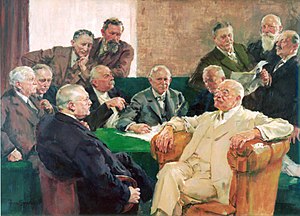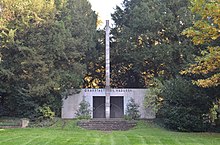Adolf Haeuser
Adolf Haeuser (born November 26, 1857 in Weilburg ; † March 13, 1938 in Frankfurt am Main ) was a German lawyer , chemist , manager and patron . From 1904 he was a board member and from 1916 to 1925 chairman of the board of Farbwerke Hoechst AG vorm. Meister, Lucius & Brüning and from 1925 to 1932 a member of the supervisory board of IG Farbenindustrie AG in Frankfurt-Höchst .
life and work
Adolf Haeuser came from a Nassau officer family. His father was Karl Heinrich Jakob Haeuser (born October 19, 1826 in Scheuert, † June 13, 1911 in Bad Kreuznach). After the annexation of the Duchy of Nassau, the latter was taken over into Prussian services and was lastly a Prussian lieutenant colonel zD. The mother of Adolf Haeuser, Wilhelmine (called Minne) Eleonore Johanna Möhn (1850–1904) was the daughter of the judiciary Jacob Johann Möhn.
Adolf Haeuser attended grammar school in Dortmund, where he graduated from high school in 1877. He studied law at the Philipps University of Marburg and at the Albert Ludwigs University of Freiburg , and later worked as an assessor at the public prosecutor's office in Wiesbaden . He then studied chemistry at the Friedrich-Wilhelms-Universität Berlin and at the Rheinische Friedrich-Wilhelms-Universität Bonn . In 1877 he became a member of the Alemannia Marburg fraternity and in the 1879 summer semester of the Franconia Freiburg fraternity .
On September 3, 1891, he married in Höchst Luisa (born Koenig; * January 26, 1869; † September 12, 1953 in Frankfurt am Main), the daughter of the industrial chemist Dr. phil. Dr.-Ing. Ferdinand Carl Friedrich Koenig (1838–1885).
In 1888 he joined the company Farbwerke Hoechst AG vorm. Meister, Lucius & Brüning , whose legal advisor he became in 1889. From 1904 he was a member of the board of directors , and in 1916 he took over the chairmanship of this body. In this function he was the architect Peter Behrens' client for the construction of the new technical administration building in 1920 .
1915-1918 he was a member of the National Liberal Party in the Prussian House of Representatives . Politically, after 1918 he was hostile to the divided party system of the Weimar Republic . As a lawyer, he particularly advocated patent law and copyright law .
From 1911 to 1917 he was a member of the Nassau municipal parliament as a representative of the Höchst district .
In the course of the establishment of IG Farbenindustrie AG (1925) he joined the supervisory board of the stock corporation and in 1926 became deputy chairman of its administrative board . In 1932 he retired.
Haeuser campaigned for the expansion of the company's social services, in particular the company health insurance funds and the construction of company apartments . Together with his wife Luisa he founded several foundations in Frankfurt (“Adolf and Luisa Haeuser Foundation for Art and Culture”, a foundation for research in the natural sciences, and on March 31, 1914 the “Adolf and Luisa Haeuser Foundation “For needy people), whose assets he increased again after the inflation . The "Adolf Haeuser Foundation for Natural Sciences" set up in a will by Haeuser and his wife to promote scientific work at the Philipps University of Marburg and the "Adolf and Luisa Haeuser Foundation" to promote the Research Institute for Art History in Marburg were established in the Approved by the Hessian Ministry of the Interior in 1955.
Haeuser was a board member of numerous cultural and scientific institutions, including the Kaiser Wilhelm Society and the Deutsches Museum . In 1921 he was elected first chairman of the newly founded Marburg University Association and held this position until his death. In 1933 he was one of the 18 foundation stone donors for the House of German Art in Munich , built in 1937 .
1921–1924 he was President of the Wiesbaden Chamber of Commerce and Industry .
Haeuser and his wife were buried in the Frankfurt main cemetery (Gewann II 192). The grave is a listed building.
Honors
Hauser has been awarded various honorary doctorates , such as Dr. theol. hc, Dr. jur. hc, Dr. phil. hc, Dr. med. hc and Dr.-Ing. Eh, among other things from the Ludwig Maximilians University in Munich and the Philipps University in Marburg . He also carried the honorary title of Privy Councilor of Commerce and in 1921 was made the first honorary senator of the Philipps University of Marburg and an honorary citizen of the city of Marburg. In 1937 he received the plaque of honor from the city of Frankfurt. Adolf-Haeuser-Strasse in Höchst is named after him, and Luisa-Haeuser-Brücke in Marburg is named after his wife.
literature
- Ernst Bäumler: The red factory. Family history of a global company. Piper Verlag, Munich 1988, ISBN 3-492-10669-2 , page 268 and more.
- Wolfgang Klötzer (Hrsg.): Frankfurter Biographie . Personal history lexicon . First volume. A – L (= publications of the Frankfurt Historical Commission . Volume XIX , no. 1 ). Waldemar Kramer, Frankfurt am Main 1994, ISBN 3-7829-0444-3 .
- Nassau parliamentarians. Part 2: Barbara Burkardt, Manfred Pult: The municipal parliament of the Wiesbaden administrative district 1868–1933 (= publications of the historical commission for Nassau. 71 = prehistory and history of parliamentarism in Hesse. 17). Historical Commission for Nassau, Wiesbaden 2003, ISBN 3-930221-11-X , pp. 126–127.
Other sources
Web links
- Newspaper article about Adolf Haeuser in the 20th century press kit of the ZBW - Leibniz Information Center for Economics .
Individual evidence
- ^ Ernst Elsheimer (ed.): Directory of the old fraternity members according to the status of the winter semester 1927/28. Frankfurt am Main 1928, p. 172.
-
↑ The architectural historian Wolfgang Pehnt wrote: “You have to read the correspondence that the General Director… and his office conducted with their architect Peter Behrens between 1920 and 1924 in order to get an idea of the appearance of a strong client. The carrot and stick changed constantly. ... Builders and houses see architecture as image cultivation. ”
Quoted from: Chances of history. Contribution to the Fritz Schumacher Colloquium on the subject of “Responsibility for the City and Building Today and Tomorrow” on November 22, 2005 in the Faculty of Architecture and Landscape at the Gottfried Wilhelm Leibniz University of Hanover . In: Netzwerk Magazin from April 2006, p. 6 f. -
↑ Bernhard Mann (edit.): Biographical manual for the Prussian House of Representatives 1867–1918. (= Handbooks on the history of parliamentarism and political parties , Volume 3.) Droste Verlag, Düsseldorf 1988, p. 161.
On the election results cf. Thomas Kühne: Handbook of the elections to the Prussian House of Representatives 1867-1918. Election results, electoral alliances and election candidates. (= Handbooks on the history of parliamentarism and political parties , Volume 6.) Droste Verlag, Düsseldorf 1994, pp. 678–681. - ^ President of the Philipps University of Marburg, board of directors of the Marburger Universitätsbund (ed.), Klaus Walter (ed.): The Uni-Bund in the Weimar Republic. In: UniJournal , No. 18, p. 61 ff.
- ^ Announcement on the approval of the Adolf and Luisa Haeuser Foundation in Marburg (Lahn) from May 13, 1955 . In: The Hessian Minister of the Interior (ed.): State Gazette for the State of Hesse. 1955 no. 22 , p. 542 , point 587 ( online at the information system of the Hessian state parliament [PDF]).
| personal data | |
|---|---|
| SURNAME | Haeuser, Adolf |
| BRIEF DESCRIPTION | German lawyer, chemist and business manager |
| DATE OF BIRTH | November 26, 1857 |
| PLACE OF BIRTH | Weilburg |
| DATE OF DEATH | March 13, 1938 |
| Place of death | Frankfurt am Main |



